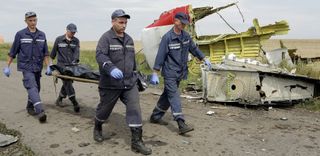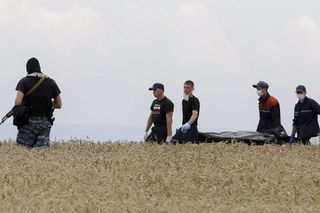
Identifying Bodies From MH17 is a Challenge For Forensics (Op-Ed)

This article was originally published at The Conversation. The publication contributed the article to Live Science's Expert Voices: Op-Ed & Insights.
Returning the 298 victims from Malaysia Airlines flight MH17 to their families with dignity and respect is a major priority for each nation involved.
Disaster victim identification (DVI) is a difficult task, but will be made even more challenging in this instance given the delays in body recovery and the interference of the crash site that is said to span over a 10km area including within a combat zone.
Australia has some of the best forensic experts in the world but they have been sidelined, with no access to the crash site or victims due to political obstruction.
Recovering the bodies
The most important phase of an identification operation is the Recovery Phase, which should be conducted by highly trained police and scientific officers. This involves thorough documentation, preservation and collection of bodies, personal property and other forensic evidence at the disaster site.

If the highest possible quality standards are not implemented at this stage of the identification operation, it may significantly delay or prevent accurate identification of victims.
Given the pictures of seemingly untrained military personnel trampling over the crash site and rummaging through the wreckage, it appears that the site has been contaminated and vital evidence has been removed.
Sign up for the Live Science daily newsletter now
Get the world’s most fascinating discoveries delivered straight to your inbox.
Untrained searchers may not recognise items of forensic value to collect or overlook smaller body parts.
The need to document
Each item of property and body part should be given a unique identifying number at the crash site before removal, which should stay with it throughout the entire victim identification process. This forms a chain of continuity that prevents loss or destruction of bodies and items and maintains the value of forensic evidence.
Given the criminal nature of this disaster, these are also vital steps in any future legal proceedings.
For any multi-national victim identification process, the nation in charge of the crash site – and that’s still in dispute – should secure participation of forensic experts from all nations who suffered victims and ensure international standards are used.
Malaysian Airlines has so far identified the passengers and crew from the Netherlands, Malaysia, Australia, Indonesia, the UK, Germany, Belgium, Philippines, Canada and New Zealand.
But despite international offers of assistance, forensic experts – including those from Australia – have not been given access to the crash site or the bodies.
Protecting the bodies
The MH17 disaster will require forensic DVI experts to conduct autopsies, fingerprint, dental and DNA analysis of the victims and compare the evidence to records such as dental charts, medical records, personal photographs and fingerprints from personal belongings.

As the remains of victims deteriorate in fields under baking sun, vital forensic clues will start to disappear such as fingerprints, tattoos, scars, birthmarks and the opportunity for visual identification.
Over the past 20 years DNA has been used in disasters such as the World Trade Centre Attacks in New York in 2001 and the Bali Bombings in 2002 and technologies have improved much over time. DNA samples should be taken of all bodies and body parts recovered from the MH17 crash site so these can be compared against DNA from the victim’s personal items or their close relatives.
The delay in recovering the bodies shouldn’t have an impact on obtaining DNA profiles from victim’s bone samples, but the delay will significantly limit DNA profiling from blood and soft tissue.
The explosion
The explosion and fire from the missile attack is another challenge for forensic experts. The associated heat and destructive forces of the initial explosion and resulting crash will make the bodies more difficult to recover and identify.
Despite the successful use of forensic science in many previous disasters, unfortunately there is always the possibility that not all victims can be identified.
To give families of MH17 passengers the best chance of having their loved ones returned, international experts need access to the entire crash area across multiples sites to conduct a thorough recovery using INTERPOL DVI standards.
Open access to evidence already collected from the crash site by pro-Russian separatists needs to be given to forensic experts. This evidence is most likely to contain valuable identification information and provide additional context to the forensic investigation.
Looking for evidence
Despite reports that bodies are now being refrigerated, forensic experts need to start autopsies on them immediately. Not only will these experts look for and recover evidence that will lead to identification, they will also search for evidence that will help to uncover what caused the crash of MH17.
The evidence will be used at Identification Boards and ultimately at a criminal court to help prosecute those responsible for such a heinous attack on innocent people.
The most important aspect of DVI is having access to evidence that can lead to fast and accurate identification and this process should be done while treating victims with respect and dignity.
There is little doubt that this access is being deliberately impeded for political reasons and the victims’ dignity has been ignored.
Kirsty Wright does not work for, consult to, own shares in or receive funding from any company or organisation that would benefit from this article, and has no relevant affiliations.
This article was originally published on The Conversation. Read the original article. Follow all of the Expert Voices issues and debates — and become part of the discussion — on Facebook, Twitter and Google +. The views expressed are those of the author and do not necessarily reflect the views of the publisher. This version of the article was originally published on Live Science.
